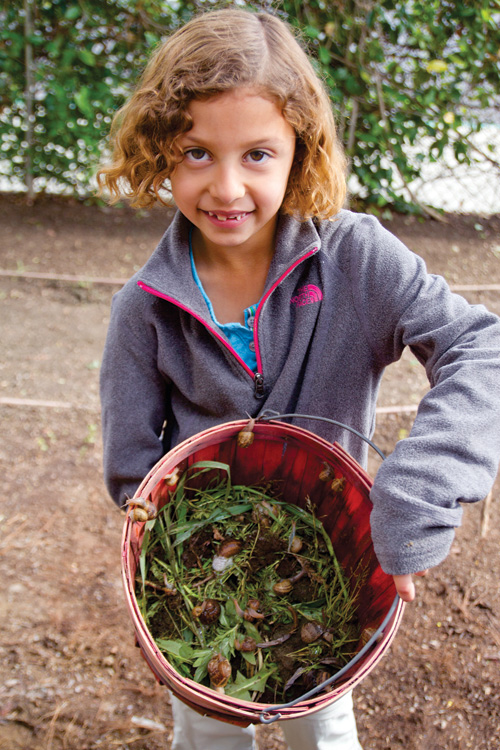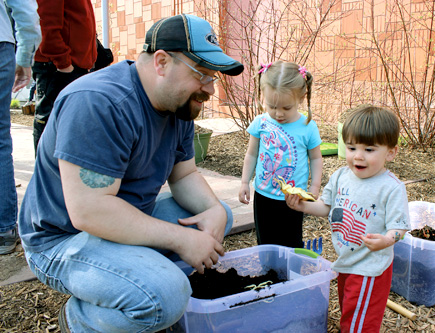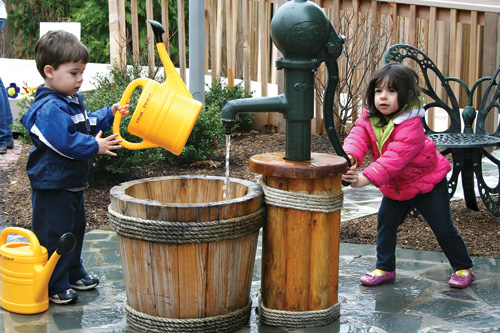Dig It! Library Gardens Sprout Up Coast-to-Coast

Photo by Grace Hwang Lynch
At the Nature Explorium in Centereach, New York, children can taste and smell flowers and herbs, build boats and float them down a creek, and try playing musical instruments from different cultures. This is not an amusement park or a private museum with a pricey entrance fee. Rather, the Nature Explorium is part of the Middle Country Public Library (MCPL) in Centereach and is free to all patrons. The 5,000-square-foot outdoor garden and learning space is a dramatic example of how libraries are creating gardens to expand their mission.
A little dirt under the fingernails can go a long way toward teaching nutritional literacy and environmental awareness. Library gardens also provide opportunities for literary tie-ins or a primer on aquaponic farming. Other times, these oases simply offer a place to rejuvenate the soul.
“It’s a way to get patrons into the library,” says Tracy LaStella, coordinator for youth services at MCPL. “We’re all struggling with that all the time, and having an outdoor space or outdoor programs is another way to reach people in the community.”
Opened in 2010 after three years of planning, MCPL’s Nature Explorium was a forerunner in bringing outdoor learning to libraries. LaStella says MCPL’s innovative atmosphere made it relatively easy to find support among local businesses and civic organizations. Half of the garden’s $300,000 start-up cost came from donors or grants. Some of the fundraising efforts tied into the love of literature, such as the library’s Book Path initiative, in which individual donors could purchase a brick inscribed with the name of their favorite book or a quote. The other half of the funding came from the library’s general budget. The Nature Explorium is now host to a variety of programs, such as a poetry-themed Haiku Hike, nature journaling workshops, and a sensory garden full of herbs.

Young gardeners at the Nature Explorium,
a 5,000-square-foot garden and learning space
at the Middle County Public Library in Centereach, New York.
Courtesy of Middle Country Public Library
Fostering nutritional literacy
The concept of gardening at libraries is taking root, so to speak, as librarians reexamine their role in their communities and a changing society. “The definition of literacy has been greatly expanding over the years,” says Helen Bloch, children’s librarian at the Oakland Public Library (OPL) in California. Bloch and other librarians see a dearth of knowledge about nature and nutrition among their youngest patrons. Seminars about garden programs are increasingly popular at regional library conferences.
“Libraries are meeting the needs of the community. One of the needs is sustainable food and living,” says Abbe Klebanoff, head of public services at the Lansdowne Public Library (LPL), located in a Philadelphia suburb. “Ours is supposed to be a sustainable demonstration of food production.”
Across the country, librarians have encountered children who didn’t know that food grows in the ground, but also kids who are willing to try a new vegetable for the first time simply because they grew it themselves. Pizza, salsa, or salad gardens—in which ingredients for those dishes are grown, harvested, and prepared at the end of summer—are popular programs. “I’ve seen a kid pick up a piece of raw kale, eat it, and pronounce it delicious,” says Karen McIntyre, a librarian at the Westmeade Elementary School in Nashville, Tennessee.
In urban Oakland, many library patrons live in apartments without yards for planting. “I really think literacy is not just encouraging families to read,” says Bloch, “but also providing a physical space so families with varied interests and varied cultures can gather.”
The need for children to connect with nature is evident across the economic and geographical spectrum. Kimberly Alberts, children’s and teen librarian at the Hudson Library and Historical Society (HLHS), located in a suburb of Akron, Ohio, notes, “In an affluent area where [kids] have access to all the technology, it’s good for them to experience the roots of being kids and experiencing the outdoors.”
Small-space gardens
While most facilities don’t have the land or budget to create a Nature Explorium, many are implementing gardening programs tailored to their resources and demographics. Patios or courtyards adjacent to children’s reading rooms can be turned into gardens with raised planting beds or large pots. Alberts says, “No matter what kind of space you have, whether you’re in the middle of a downtown urban library or if you have a beautiful reading area, this is something you can do.”
Some innovative gardens do not even require dirt. At the Cranbury School in Cranbury, New Jersey, media specialist Kelly Fusco started an aquaponics program in the cafeteria. A large tank houses goldfish, while mint, basil, and bell peppers grow in a mixture of rocks and water. These plants, along with strawberries grown in small pots, get nutrients from fish waste, and the system is replenished with rain water. First- and fourth-graders work together to feed the fish and monitor the plants.

The Middle County Public Library aims to make literacy, learning,
and appreciation for nature all part of children’s library experience.
Courtesy of Middle Country Public Library
Curricular tie-ins
For many libraries, gardening enhances existing programming rather than standing alone as a separate activity. At OPL, the garden outside the children’s room entrance was an offshoot of a 2013 summer reading program called “Reading Is So Delicious.” The outdoor reading programs take place on Thursday afternoons, immediately following the free lunch served by the Alameda County Food Bank every weekday. While garden themes often revolve around cooking, programs can also help launch lessons about Native Americans or flora and fauna, such as HLHS’s Butterfly Garden.
While many schools have already implemented gardens as part of their science or general curricula, school librarians often take the lead. McIntyre came up with the idea for a garden after talking with Westmeade Elementary’s physical education teacher, who was concerned about the students’ poor diets and inactivity. McIntyre says, “Many places are still fighting the battle to use the library as an integral part of the overall school curriculum.”
Planted in 2009, the Westmeade garden now inspires many educational tie-ins. “I use the garden with English literature, writing, journaling, and observing differences over time,” McIntyre explains. “It connects in ways far beyond science.” She also takes advantage of the garden to reinforce local culinary culture, hosting a fried green tomato party each year.
Seed money
Libraries commonly rely on grants and local fundraisers to fund gardens. The HLHS container garden was started with plants donated by a local garden center, planted in pots borrowed from staff. LPL started a “Bookworm” program two years ago with a $500 grant from a local nonprofit organization, the Lansdowne Yeadon Elm Street Program. During library seminars, children make healthy snacks and feed the leftovers to the red wiggler worms, which create compost. Klebanoff says, “We had all this compost, so I thought, ‘Why don’t we do a library garden?’”
With another $500 grant from the Pennsylvania Horticultural Society, Klebanoff used the compost produced by the library wriggler “bookworms” to plant tomatoes, peppers, and herbs in a small outdoor garden. While introducing many children to the tastiness of fresh vegetables, the garden also serves as an outdoor setting for the library’s popular story time, an opportunity to teach young patrons more about nature.
OPL was awarded an $8,000 grant from the Institute of Museum and Library Services. The library used it to purchase gardening supplies and 300 new books, marked with stickers that indicate they are part of the gardening program, as well as hiring an instructor for weekly gardening lessons.

At the Cranbury (NJ) School, fish tank water cycles through a watering
and irrigation system for strawberries, peppers, mint, and basil.
Courtesy of The Cranbury School
How to ensure a lasting harvest
Gardening and nature groups with local chapters, such as Master Gardener and Horticulture Society organizations, have been key resources for library gardens. Some regional library conferences—such as the Association of Children’s Librarians of Northern California or the Northeast Ohio Regional Library System—have also included gardening presentations. Veterans of library and school gardens say that growing a program slowly and gathering community support is crucial to long-term success. Since 1971, the Hacienda Science Magnet School in San Jose, California, has maintained a garden that blossomed into a one-acre outdoor classroom. Kevin Keedy, science resource teacher at Hacienda, stresses the importance of having a committed group of volunteers, as well as staff, to oversee the long-term vision. “It’s easy to get a grant to start stuff, but you need someone to keep it going,” he says.
Many librarians start off as their gardens’ sole caretakers. With a staff of only two at LPL, Klebanoff watered and turned the soil mostly by herself last summer. This year, she has seven youth volunteers. “A couple kids who helped last year said they ended up enjoying it and wanted to continue,” she says. “They also said they were going to bring friends!”
Because teachers and librarians are often overburdened, McIntyre says that it’s key to notice people who show interest, and nurture a core group of volunteers. She does this by inviting families to a spring garden picnic, when people sign up to water and weed during the summer.
Such activities, McIntyre says, illustrate a fundamental, shared quality of both libraries and gardens. “It ties back to the basic premise that the library is a place you go for refreshment of your soul,” she says. “Whatever you need to learn, you go there to find out. It opens up this whole amazing developmental idea. To me, that’s what a library has always been.”
RELATED
The job outlook in 2030: Librarians will be in demand
The job outlook in 2030: Librarians will be in demand
ALREADY A SUBSCRIBER? LOG IN
We are currently offering this content for free. Sign up now to activate your personal profile, where you can save articles for future viewing





Add Comment :-
Comment Policy:
Comment should not be empty !!!
Dottie Mepham
I absolutely LOVE this idea. I have been thinking about trying to implement a school garden at my school for awhile now. I recently took on the librarian position at our school and reading this article is giving me some great ideas about starting this at our school! I am so excited about the possibilities! :)Posted : Sep 17, 2014 08:06